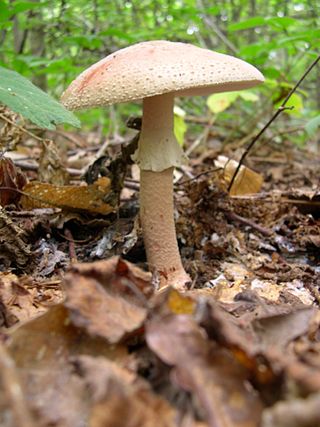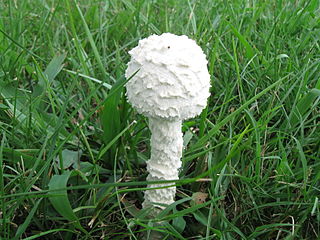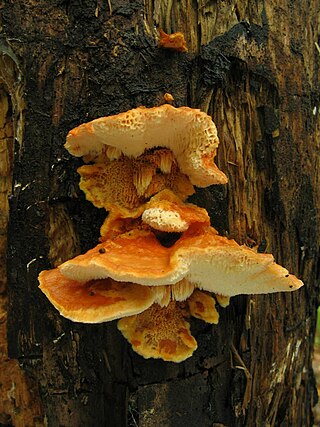
Edible mushrooms are the fleshy fruit bodies of several species of macrofungi. Edibility may be defined by criteria including the absence of poisonous effects on humans and desirable taste and aroma. Mushrooms that have a particularly desirable taste are described as "choice". Edible mushrooms are consumed for their nutritional and culinary value. Mushrooms, especially dried shiitake, are sources of umami flavor.

The Strophariaceae are a family of fungi in the order Agaricales. Under an older classification, the family covered 18 genera and 1316 species. The species of Strophariaceae have red-brown to dark brown spore prints, while the spores themselves are smooth and have an apical germ pore. These agarics are also characterized by having a cutis-type pileipellis. Ecologically, all species in this group are saprotrophs, growing on various kinds of decaying organic matter. The family was circumscribed in 1946 by mycologists Rolf Singer and Alexander H. Smith.
Fungiculture is the cultivation of fungi such as mushrooms. Cultivating fungi can yield foods, medicine, construction materials and other products. A mushroom farm is involved in the business of growing fungi.

The blusher is the common name for several closely related species of the genus Amanita. A. rubescens, or the blushing amanita, is found in Europe and eastern North America, and A. novinupta, also known as the new bride blushing amanita, is found in western North America. Both their scientific and common names are derived from the propensity of their flesh to turn pink upon bruising or cutting.

Nepenthes spathulata is a tropical pitcher plant native to Java and Sumatra, where it grows at elevations of between 1100 and 2900 m above sea level. The specific epithet spathulata is derived from the Latin word spathulatus, meaning "spatula shaped", and refers to the shape of the lamina.

A cystidium is a relatively large cell found on the sporocarp of a basidiomycete, often between clusters of basidia. Since cystidia have highly varied and distinct shapes that are often unique to a particular species or genus, they are a useful micromorphological characteristic in the identification of basidiomycetes. In general, the adaptive significance of cystidia is not well understood.

Sparassis is a genus of parasitic and saprobic mushroom characterised by its unique shape and appearance and is found around the globe. Its appearance can be described as similar to a sea sponge, a brain or a head of cauliflower, hence its popular name.

Sparassis crispa is a species of fungus in the family Sparassidaceae. It is sometimes called cauliflower fungus.

Helvella crispa, also known as the fluted white elfin saddle, white saddle, elfin saddle or common helvel, is an ascomycete fungus of the family Helvellaceae. The mushroom is readily identified by its irregularly shaped whitish cap, fluted stem, and fuzzy undersurfaces. It is found in eastern North America and in Europe, near deciduous trees in summer and autumn.
Coastal strand is a plant community of flowering plants that form along the shore in loose sand just above the high tide line.

Chlorociboria is the type genus of in the fungal family Chlorociboriaceae within order Helotiales. The genus includes 23 species.

Cyathula is a genus of medicinal and ornamental plants in the family Amaranthaceae. They are distributed in Africa, Asia, Oceania and the Americas.

Grifola frondosa is a polypore mushroom that grows at the base of trees, particularly old growth oaks or maples. It is typically found in late summer to early autumn. It is native to China, Europe, and North America.

Saproamanita thiersii, commonly called Thiers' lepidella, is a North American saprotrophic basidiomycete fungus in the genus Saproamanita. It is a white, small mushroom. Its cap is convex, measuring 3.5–10 centimetres across, and the stipe is 8–20 cm (3–8 in) long. The spore print is white.

Paradisbakkerne, also Helvedesbakkerne, is a group of hills in Denmark, located in the east of the island of Bornholm. It is situated approximately 3 kilometres (1.9 mi) northwest of Nexø. The privately owned area consists of hilly, rocky landscapes with narrow rift valleys lined by almost vertical cliffs, making it popular for nature walks. Typically, the hills rise to a height of 30–50 metres (98–164 ft) above the surroundings in a forested area which also has a number of small lakes and marshes. Midterpilt, 113 metres (371 ft) above sea level, is one of the highest points. Although much of the area is now wooded, it was once covered with heather and low shrubs, making it suitable for grazing. Paradisbakkerne has a long cultural history, attested by numerous place names with their own legends and stories. These include Slingestenen, Linkisten, Ligstenen, Dybedal, Ravnedal, Majdal, and Gamle Dam.

Sparassol is an antibiotic and antifungal isolated from Sparassis crispa.

In Finland, Kotiranta and Niemelä introduced a widely used method for comparing the conservation values of different forest areas, based on the observation that certain wood-rotting fungi are very sensitive to the impact of human activities on forest ecosystems. Such species are slow to return to areas from where they have disappeared, so their presence is evidence of a long continuity in forest ecosystems.

Perilla is a genus consisting of one major Asiatic crop species Perilla frutescens and a few wild species in nature belonging to the mint family, Lamiaceae. The genus encompasses several distinct varieties of Asian herb, seed, and vegetable crop, including P. frutescens (deulkkae) and P. frutescens var. crispa (shiso). The genus name Perilla is also a frequently employed common name ("perilla"), applicable to all varieties. Perilla varieties are cross-fertile and intra-specific hybridization occurs naturally. Some varieties are considered invasive.
















